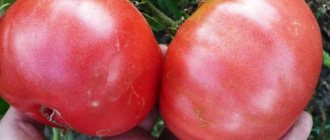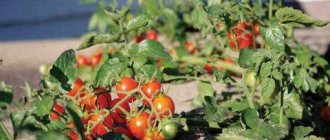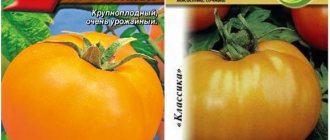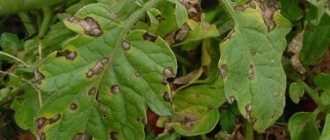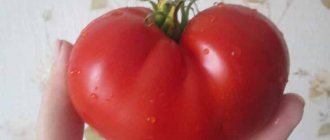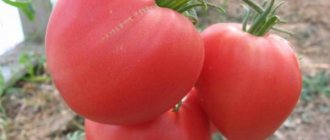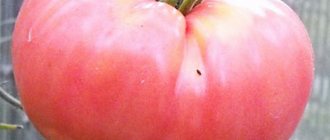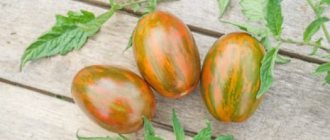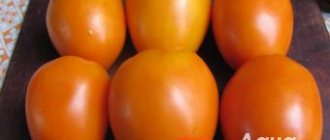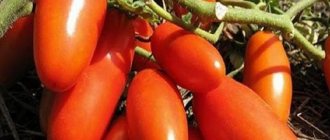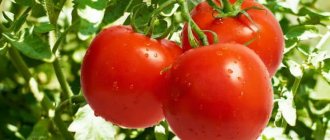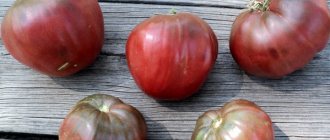Tomatoes have been famous for thousands of years; they appeared in European countries, coming from South America in the sixteenth century. Residents of Europe really liked the taste of this vegetable crop, as well as the versatility of the fruit and the variety of possible dishes that can be prepared using tomatoes, for example, salad, snacks, cream soups, and so on. Breeding specialists have not stopped improving and developing tomato varieties for several millennia, making the selection of packaging with the necessary planting material quite complicated. Next we will talk about the newest variety of tomatoes, namely the main characteristics, cultivation methods and description. The Stolypin tomato, which has a completely justified popularity among summer residents and tomato lovers, despite the small number of years of existence on the market.
Description of tomato Stolypin
Let's look at the characteristics and description of the Stolypin tomato variety in more detail. The Stolypin tomato is a variety (not a hybrid, but a variety) bred by Russian breeders from the Aelita agricultural association in 2004.
The Stolypin tomato is a determinate tomato, that is, its growth slows down at a certain level and it begins to form tomato clusters. In the Stolypin tomato, the topping of the stem occurs already when the ovaries are formed on the first clusters.
The structure of the stems and leaves is typical for any representative of tomatoes and does not differ in any particularities. Stems up to 10-12 mm in diameter, dark green, slightly pubescent. The leaves are dissected into large lobes (usually 5, rarely 7). The flowers are small in size, collected in inflorescences of 3-10 pieces. The flowers have 6 petals, their diameter is about 7-10 mm.
But the structure of a tomato bush has some special characteristics due to determinant features. The plant is a short bush (no more than 50-60 cm). The structure of the bush is not standard; the diameter of the “crown” without formation can exceed the height of the plant.
A photo of the Tomato Stolypin bush is presented below.
Flowering begins relatively early (usually the seedlings are already blooming). The ripening period for tomatoes of this variety ranges from 3 to 3.5 months from the moment of germination. As with all determinate varieties, all clusters ripen at approximately the same time.
Description of fruits
Tomatoes are collected in clusters of 5-6 pieces. Usually the first brush is located at the level of the 6th sheet from the bottom. The fruits are small flattened plum-shaped balls, however, this is not the usual familiar “cream” with a hard core and an almost complete absence of taste.
Stolypin tomatoes have excellent taste and pulp consistency. They contain sufficient amounts of sugars, vitamins and minerals. The weight of tomatoes reaches 120 g, but these are record-breaking fruits. On average, the weight of tomatoes is 80-90 g. The color of the fruit is red-pink or red.
The skin of tomatoes is elastic and dense, it is quite difficult to damage it. Inside the pulp there are 3-4 chambers with seeds; the number of seeds is small - about 30-40 pieces in one berry.
Growing seedlings
This variety is grown in seedlings, so the seeds are sown in advance so that by the end of spring several pairs of leaves have already formed on the plant.
Seeds for sowing are used both purchased and collected from last year's fruits. The manufacturer of planting material of the Stolypin variety is.
Preparing seeds for sowing
Before sowing seeds to obtain seedlings, they are prepared. If you bought seeds from the manufacturer, it does not need processing. Using last year's seeds involves 2 procedures:
- disinfection. To do this, use a solution of potassium permanganate (30 g per 2 liters of water), into which the seeds are placed for 20 minutes;
- hardening. After disinfection of the planting material, it is hardened to increase resistance to unfavorable climatic conditions. To do this, the seeds are placed on the bottom shelf of the refrigerator and kept in such conditions for 4 hours.
Sowing seeds for seedlings
When the seeds are prepared, they are sown in small containers. To protect the culture from fungi and bacteria, containers are treated with copper sulfate (30 g per 10 liters of water). This way you will destroy all harmful microorganisms that can reduce the yield of Stolypin seedlings.
Nutrient soil is poured into the container, which can be easily prepared at home. It is enough to mix 5 kg of humus, 3 kg of sand and 7 kg of garden soil.
A small depression is made in the soil, literally 1.5 cm. Seeds are placed and sprinkled with peat. To speed up the emergence of seedlings, cover the containers with plastic wrap. After this, the containers are transferred to a dark room and left until shoots emerge. When this happens, the film is removed and the containers are placed in a lighted place.
Care
Caring for seedlings is easy. It is enough to provide it with high-quality watering, loosening the soil and an optimal level of lighting. Water the seedlings no more than once a week. A spray bottle is used for this. Water for irrigation should be warm and settled.
Loosening the soil is carried out 2 times a week. If the sun is not enough, use fluorescent lamps. They are placed on all sides of the plant so that it is illuminated evenly.
Characteristics of the tomato variety Stolypin
The characteristics of the Stolypin tomato can be called optimal for growing in any climate. Possessing a short stature, it nevertheless maintains a sufficient level of productivity. The taste qualities of this variety are perfectly combined with the preservation of the outer shell of the fruit during preservation.
Tomato yield Stolypin
The yield from one tomato bush is from 1.5 to 2.5 kg per bush, which is a fairly good characteristic, given the small size of the plant. The flowering period is relatively short, no more than 2 weeks. Ripening of tomatoes on all clusters occurs almost simultaneously.
Important! To speed up the ripening process of individual tomatoes or whole bunches, it is recommended to collect ripe fruits from the bunch without waiting for it to ripen entirely. This way, nutrients will be directed to unripe vegetables and speed up their ripening.
Area of application of fruits
The fruits have almost universal uses. They are used to prepare salads, sauces, tomato juice and tomato paste. However, the main purpose of this fruit is preservation. Having a fairly strong skin, this variety is able to retain the shape of canned fruits during heat treatment.
Unlike many “cream”, which also have a strong peel, but rather mediocre taste, the Stolypin tomato has much more flattering reviews, since its pulp has an exceptional taste. The taste rating for this variety is 4.9 out of 5.
Resistance to diseases and pests
According to reviews collected by Aelita, the Stolypin tomato variety has very high resistance to late blight, but is susceptible to other fungal infections. These include the following diseases:
- macrosporiosis;
- anthracnose;
- septoria;
- gray rot.
However, the plant has good resistance, and 1-2 treatments with fungicides are enough for the fungi that cause these diseases to recede.
Among bacterial and viral diseases, Stolypin is highly resistant to mosaic, although it can sometimes undergo necrosis, especially during the formation of brushes. However, cases of the latter type of lesion are quite rare.
Advantages and disadvantages of the variety
Advantages of the Stolypin tomato variety:
- high yield rates;
- resistance to difficult weather conditions;
- high resistance to late blight;
- excellent taste characteristics (4.9 points out of 5);
- strong skin prevents tomatoes from cracking during canning;
- can be grown almost throughout the entire territory of the Russian Federation.
Disadvantages of the variety:
- when the summer is too hot (temperatures +30 °C and above), the flowers begin to dry out;
- the plant requires bush formation and garter;
- In humid summers there is a risk of fungal diseases.
Advantages
Among the advantages of the Stolypin tomato are:
- resistance to low growing temperatures. The growth of the crop and the formation of ovaries does not stop in cold weather;
- the harvest has time to ripen in regions with short, cool summers;
- tasty, juicy pulp, pleasant aroma of fruits;
- small fruit sizes are convenient for preservation;
- immunity to late blight and other diseases of the Solanaceae family;
- resistance to cracking of ripe tomatoes, good transportability;
- compact size of the bush, allowing rational use of the area of the site.
Stolypin tomatoes form a large number of ovaries, which, when ripe, can lead to breaking off the stems. The bushes require staking to a support. This is the only drawback that vegetable growers note.
The Stolypin tomato variety is one of the most popular when grown in regions with cold climates, since it is distinguished by early ripening of fruits, as well as the resistance of the plants themselves to cold snaps. The list of important advantages also includes:
- resistance of the variety to late blight;
- balanced sweetish taste of ripened fruits;
- resistance to peel cracking, including during prolonged heat treatment;
- versatility of fruit use, especially tomatoes are suitable for whole-fruit canning;
- the ability to grow tomatoes for the purpose of further sale (including under conditions of long-term transportation).
The variety is in great demand
According to the description, the variety is characterized by the following positive qualities:
- immunity to late blight;
- excellent taste and commercial quality;
- resistance to low temperatures;
- no cracking during ripening or storage.
Features of planting and care
Working with seedlings
Traditionally, tomatoes are grown using seedlings. Its planting should be carried out approximately 2 months before planting in the garden. The latter usually occurs in mid-May, when the probability of frost tends to zero.
Planting is carried out either in individual containers or in a common box. For the first week, the seedlings should be covered with film and placed in a dark and warm place.
The first shoots appear in about a week. After this, the box with seedlings is brought out into the light, and the room temperature is maintained within +18-22 °C.
Attention! If there is not enough light, the seedlings begin to stretch. Additional lighting with lamps will help avoid this.
Plants are picked when they have 3 true leaves. Typically, picking is done by placing the plant in a peat pot.
With a sufficiently large volume of soil, when transplanting into open ground, the root system of tomatoes is practically not damaged.
Planting in open ground
Before planting in open ground, it is necessary to harden the seedlings. A week before the planned planting, the box with seedlings is placed in the open air for about half an hour. On the second day, this time is increased to 1.5-2 hours. By the last day of hardening, the seedlings should stand in the open air for 24 hours.
Tomatoes of the Stolypin variety prefer sunny areas. Staying in the shade can affect the ripening time or their taste.
Tomatoes are planted in holes with a diameter of 15 cm, at the bottom of which humus or compost is placed. When planting, a 70 x 30 or 70 x 40 cm scheme is used. It is recommended not to place it on 1 square meter. m more than 6 bushes. It is considered optimal to place 4 bushes in this area.
After planting, compact the soil and water the plants abundantly.
Bush formation
This procedure is not mandatory, but it should be carried out for optimal access of light to the plant and the correct direction of its resources.
Two schemes are usually used:
- formation of a bush with 1 stem (used mainly for open ground);
- 3 stems (for greenhouse cultivation).
In the first case, all side shoots that do not have ovaries are removed. In the second, the first two lateral shoots (the lowest ones) are preserved, the rest are removed.
The tying of the stem and brushes is also carried out based on the chosen formation scheme.
Other types of care
Watering and fertilizing are carried out at intervals depending on the growing conditions and are determined primarily by the temperature and humidity of the surrounding air.
Typically, watering is done once every 2-3 days, and organic fertilizers (a solution of mullein in water) are applied once every 1-2 weeks.
Loosening the soil is usually combined with watering. It is recommended to loosen wet soil to a depth of 1.5-2 cm after each watering or fertilizing. If using mulch, this is not necessary.
Weeds should be removed regularly.
Growing seedlings
The Stolypin tomato is easy to grow as seedlings: in a cold greenhouse or on a windowsill.
Growing in a film shelter
To get a lot of strong and healthy seedlings, sow the seeds under a film cover, so the plants will grow more adapted and resistant to temperature changes and open ground conditions.
- Sowing is done in an already heated greenhouse (you need to cover it and let it stand for about a week).
- The distance between the rows is 105-20 cm, the seed placement depth is 1-2 cm.
- Try to sow sparser, about 5 cm between seeds.
- After sowing, water and cover with film.
- When the seeds sprout, you need to break through the crops so that the distance between the plants is 5-7 cm.
- Tomatoes that have grown to 5-7 cm in height need to be covered with soil to the level of the real leaves to stimulate the growth of lateral roots. Be sure to water it.
- On warm days, we lift the film for ventilation; on hot days, we remove it completely; the inside air temperature should not rise above 24°C so that the plants do not “cook.”
- You can feed 1-2 times with any nitrogen-containing fertilizer. Urea, saltpeter - 1 tbsp. l. on a bucket of water, you can water it from a watering can over the leaves. Tomatoes respond well to feeding with fermented chicken manure - 0.5 l. thick slurry per 10 liters of water. The leaves become dark green and the legs become plump.
The seedlings that have grown to a height of 10-15 cm are planted in a permanent place. To pull up seedlings, water deeply and let the soil become damp. After 1-1.5 hours, the plants can be easily pulled out by hand by the roots.
Growing seedlings on a windowsill
How to grow tomato seedlings Stolypin
In order not to be fooled once again, plant the seeds one or two at a time in the cells of the seedling cassettes. When the seedlings rise, transfer them to larger cups, deepening the trunk to the level of the real leaves. This cunning technique allows you not to disturb the root system, but at the same time get well-developed additional lateral roots.
If there is not a lot of space, sow in a common container and then dive into separate cups
It is important that the seedlings do not stretch: for this, do not place them in a warm place, it is better to grow them in a cool room, but give them a lot of light, if possible, supplement them with a phytolamp
Watering should be done moderately so as not to provoke blackleg disease. The grown seedlings are taken outside and hardened for a week before planting in the ground.
